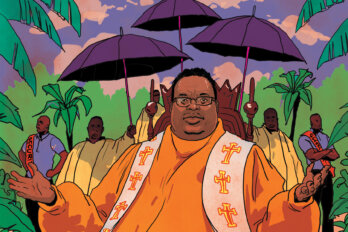In March 2021, a plain van pulled up outside Anneli Roberts’s three-room cottage, in rural North Wales. A delivery driver stepped out of the van and knocked on the cottage’s door. But Roberts was too afraid to answer. She hadn’t ordered anything and wasn’t expecting anyone.
Her thoughts began to race. Had the driver been watching her cottage? Maybe he was knocking because she was home alone? Alarmed, she turned all the lights off and hid in a doorway where no one outside could spot her. After a few more knocks, the man drove away.
This reaction to a stranger isn’t necessarily unusual for Roberts. She has had anxiety—including social anxiety—her entire adult life. She also lives with agoraphobia, which she developed after spending four years with an abusive partner. She notes that not many people know how diverse agoraphobia triggers can be: she’s not necessarily afraid of outdoor spaces. Instead, her agoraphobia stems from her fear of being in public places and interacting with strangers, particularly male ones. A few months after the incident, Roberts recalls that moment in March as one of her lowest points. She doesn’t think she would have reacted quite the same way if she’d been mixing with people more often for the last year and a half.
The COVID-19 pandemic worsened her agoraphobia and social anxiety, simultaneously legitimizing her fear of interactions and leaving her unaccustomed to navigating them. Now, public health restrictions in the UK are lifting, and she is sitting with mixed feelings. “I don’t feel ready for the return to normal, but I do want it because I know it’s important for people,” she says. “I just don’t know how I’m going to go from nothing to everything with all the mental health issues that I’ve got going on.”
There are many reasons to celebrate the end of pandemic isolation, but the trauma of the past year and a half has had profound impacts. As vaccination rates in wealthy countries increase and restrictions lift, many people are anxious about a return to “normal” life. Canada and the US are in various stages of reopening, with some regions just starting to offer outdoor dining and others allowing indoor socializing, which by this point can feel almost foreign—mixing households, dancing at clubs, and mask-free exercise classes. Anxiety is understandable: for more than a year, we’ve been told that physical proximity to other people is dangerous and should be avoided. Most of us, though, will experience only some discomfort and awkwardness as we readjust to making small talk and meeting new people.
But, for those who, like Roberts, had social anxiety or similar conditions prepandemic, psychologists are warning that the transition to postpandemic socialization could be rockier. As Roberts puts it, “I think, for people without social anxiety or agoraphobia in the first place, they would think there’s reason to be wary of other people. For somebody who’s already wary, it takes it a step further.” The prospect of returning to life outside their homes can seem even more daunting—but not impossible.
It can be difficult even for experts to understand where social uneasiness ends and social anxiety disorder begins. Social anxiety involves a combination of heightened self-awareness, negative thoughts about oneself, and negative feelings like nervousness or embarrassment. That combination flares up when socially anxious people are in the presence of others. “People with social anxiety are so concerned about all aspects of how they come across,” explains Ingrid Söchting, a clinical psychologist at the University of British Columbia. “They get into a lot of mind-reading.” Physical symptoms often follow, like a racing heart, an upset stomach, or shortness of breath. As a result, socially anxious people may avoid social situations or employ strategies to feel safer, like staying quiet.
When social anxiety becomes an impediment to functioning in life, it can be classified as a disorder. According to Anxiety Canada, social anxiety disorder is among the most common anxiety conditions. Still, as Söchting says, “It’s a very debilitating and poorly understood anxiety disorder.”
When public health orders descended last year, those with social anxiety—at least, those fortunate enough to stay home—found themselves in a protective environment. Daily life settled into predictable patterns, and expectations for socialization were reduced. Anxiety-inducing situations, such as eye contact, became much easier to avoid. A recent study on undergraduate students reported that, even as symptoms of depression and trauma-related anxiety increased, subjects experienced diminished symptoms of social anxiety during the pandemic. “Initially, people with social anxiety disorder felt some relief,” Söchting says.
That was the case for Connor, who worked in a kitchen in Burlington, Ontario, and has experienced social anxiety his whole life. (Connor asked to use his first name due to the stigma that still surrounds mental illness.) When the pandemic threw the hospitality industry into disarray, he found himself without a job. The circle of people with whom he interacted shrank. When I ask if that made him feel like a weight had been lifted, he responds, “Yeah, absolutely. I was excited to have an excuse to be alone.” He threw himself into an online music project with a friend who lives in China, rising early and working on it for hours every day. He describes the beginning of isolation as “weirdly activating.”
But, now, Connor says that he’s anticipating a rough transition back to social interactions. Söchting says concerns like this are valid. “When you’ve been hiding out inside the comfort of your home, it makes perfect sense that the world seems scarier than when you left it.” Partway through the pandemic, Connor realized he needed to try harder to stay in touch with friends. By the time we speak, in May, he describes his social life as sparse. “I felt like I was never going to meet new people again,” he says. “I’m nineteen and things are going to change, but it feels like I’m trapped right now.”
Still, Connor plans to plunge himself into socialization early—he’ll be moving in with unfamiliar roommates soon. The thought causes his anxiety to flare up. “I’m like . . . I’ve got to keep to myself. I can’t talk to people because bad things are going to happen.” But he is aware that, as much as he’s inclined to stay closed off, it’s not good for him. “I’m just going to learn, and it’s going to be what it is,” he says.
Clinical psychologist Melanie Badali of North Shore Stress and Anxiety Clinic, in Vancouver, emphasizes that avoiding anxiety-provoking situations is a barrier to recovery. The “gold standard” for social anxiety treatment, she says, is cognitive behavioural therapy (CBT). “One of the things that we do in cognitive behavioural therapy is we take thoughts and reality check them,” she says. “Are those thoughts fact or are they speculation, and can we go test them out?” For example, someone who is anxious about turning their camera on in an online class can “reality check” the threat that they are perceiving. That thought process might look like this, Badali says: “This is a reasonably safe situation; when I look around at other people, nobody else seems to be struggling with this. Everybody’s telling me that it’s safe to turn my camera on. I’m going to make myself do it.”
“We do need to challenge ourselves and say, ‘Hey, that’s my anxiety telling me that that situation is threatening or dangerous,” she says. She acknowledges that this process can be very difficult—it entails entering into the anxiety-inducing situation to learn that it can be handled—but it is also valuable. “Brave behaviour isn’t about the absence of anxiety or fear,” she says. “It’s about feeling afraid and doing something anyway.”
For some, the anxiety isn’t about strangers: it’s about people they know and love. Lauren MacDonald, who lives in Toronto, has OCD, which primarily manifests through something she calls “friendship analysis.” She tells me that she used to create “systems” on paper, using them to visualize how close she was with certain people and how distant she was from others. “I obsess over how people perceive me,” she says. “I would get very in my head about the degree of closeness I had with my friends.” This obsession stems from an underlying desire for all her interactions to be positive.
Toronto has been called North America’s lockdown capital, with lengthy shutdowns and bans on indoor dining. As a result, MacDonald hasn’t seen much of her friends in the past year. If she were to create one of her analysis systems now, nearly everyone would be further away. Reintroductions may be in order when she sees her friends again: she doesn’t feel like the same person she was when the pandemic began. “I feel like my speech patterns and the way I act have regressed,” she says. “It’s weird to be around people my own age because I’ve been spending a lot of time with the people who have known me since I was very young. I feel like I need to reacclimatize myself to being nearly twenty-one.”
In all, reopening will not be easy—and, at times, it will be deeply tiring. “Even with the people I love the most, if I don’t get alone time between spending time with them, I am really drained,” Roberts says. Anxiety, Badali explains, is a high-arousal state that comes with a negative emotional charge, as opposed to calm, which is low arousal and positive. In the short term, she says, anxiety and increased arousal can actually energize people to handle stressful situations. However, over time, remaining in highly aroused states can lead to fatigue and burnout.
Still, there are steps that socially anxious people can take to care for themselves as they face reentry into public spaces. For starters, they can be gentle with themselves. “I want to give myself permission to spend time at home if I need to,” MacDonald says.
For a more structured strategy, Badali suggests that socially anxious people create “fear ladders,” which entails setting a goal and then moving toward it in gradual steps. She uses the example of wanting to go on a date in person—maybe you start by joining a dating app and looking around without enabling people to contact you. Then, maybe you begin having conversations without meeting in-person and work your way up to a coffee meeting in a public setting. “You don’t have to jump right in,” she says.
Although, Söchting says, professional CBT treatment offers the best chance of recovery, accessing psychotherapy for social anxiety disorder can cost up to $200 per session out of pocket in Canada. With those barriers to access in mind, she says that people can treat themselves informally. For example, they can access Anxiety Canada’s variety of free resources, including a CBT app called MindShift and psychoeducational materials such as self-help strategies for social anxiety. Anxiety Canada’s My Anxiety Plan program—also free—draws upon CBT to teach healthy coping mechanisms and ease people into facing their fears. Similarly, Australian organization This Way Up offers an online CBT course for social anxiety that imparts helpful skills for managing and working through symptoms of the disorder. With a prescription from a general practitioner or mental health professional, the course is free and available worldwide.
Roberts is eager to work on her recovery. “I can’t help but feel like I’ve lost a lot of time,” she says. “When you’re in a domestic violence situation, you’re isolated by force from the people you love.” She has been recovering for nearly five years, but the pandemic has consumed about a third of that time.
Even with the mental health challenges Roberts faces, there is much for her to look forward to. “I would love to meet up with people and go for walks. That would be a really big breakthrough for me.”
Correction August 31, 2021: An earlier version of this article stated that accessing psychotherapy for social anxiety disorder can cost up to $200 out of pocket in Canada. In fact, it can cost up to $200 per session. The Walrus regrets the error.




